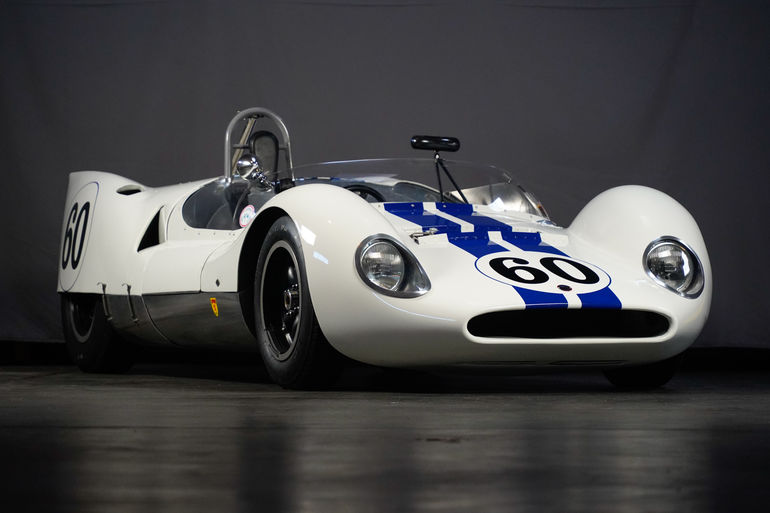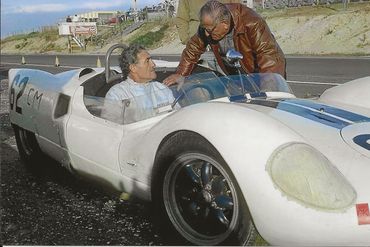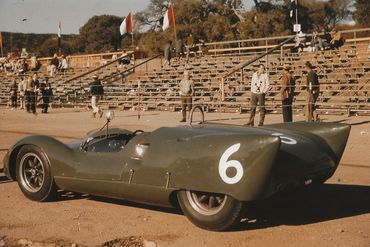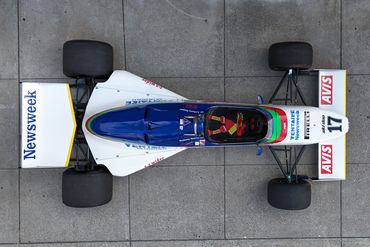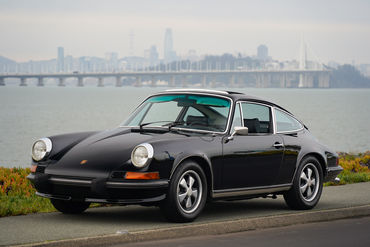Inventory
$375,000
1961 Cooper
Monaco Mark III Type 61
First driven in period by Bruce McLaren, Ex-Briggs Cunningham. Recently victorious at Rolex Reunion and Velocity International. Shown at The Quail. Arguably the most historically significant Cooper Monaco in existence
- VINCM/3/61
- Exterior ColorWhite with Blue
- Interior ColorBlack
- MileageTMU
- Engine3.5 Litre Buick V-8
- TransmissionZF 5-Speed, (Cooper transaxle included)
- StatusInventory
- StockFJ1580
Description
1961 Cooper Monaco Mark III Type 61
Chassis no. CM/3/61
White with Black Interior
Groundbreaking History
The Cooper Car Company is regarded as one of the most important British Motorsports companies in the world. A modest and agile powerhouse throughout post war racing, the Surbiton, England firm elated enthusiasts, drivers, spectators, and press with their engineering efficiency and nimble capacity on racetracks all over the world. Famous for having performed significant and ground-breaking engineering for rear engine Formula cars, Cooper Cars attracted some of the most celebrated drivers of the period including Sir Sterling Moss, Juan Manuel Fangio, Jack Brabham, Bruce McLaren, and Pedro Rodriguez. Jack Brabham himself delivered two World Champion Constructors victories for Cooper in 1959 and 1960. Throughout the 50s and 60s Cooper rear-engine race cars dominated the racing scene benefiting from their pioneering technology much of which remains in use today. Cooper developed and refined lightweight honeycomb monocoque construction, specialized engine tuning for their powertrains, including numerous racing innovations which would find their way to production cars. Cooper dominance was not limited to Formula One, as the Mini-Cooper proved on Rally courses worldwide, the Cooper name would become synonymous with performance excellence – a herald that remains today.
Innovated to Win
The Cooper Monaco was a very special, uniquely constructed, low profile, lightweight sports racer, which earned its name in honor of the Cooper victory at the 1958 Monaco Grand Prix. First introduced in 1958, ongoing Formula technology was applied to refinements in the Mark II (first offered in 1960) and again in the Mark III. Type 61 Mark III development was particularly important in that it included a new stiffer chassis, in-house hand-formed alloy body panels, and replacement of the former transverse rear leaf spring configuration with double wishbone, coil spring suspension. Most memorably, the rear fenders of the Mark III were formed with elevated, pointed fins, constructed in this fashion to aid in high-speed stability.
Innovation is a tricky business. Especially when racing. In this capacity, Cooper’s success was in part due to a fine line balancing engineering innovation and durability. Spanning six years, Cooper Monacos would win 16 races (including 2 class wins), achieve 23 podium finishes, and clinch three pole positions. In 1961 when FIA regulations pivoted to GT cars, Cooper Monacos arrived in North America to compete in what would eventually become FIA Group 7 Can-Am racing. The Cooper Monaco was so successful that Carroll Shelby, frustrated from the lack of his Cobra performances in the Can-Am series, purchased two 61M chassis for fitment of the 289 Ford V8 engine, preparing two cars and subsequently earning the attention of Ford for the GT40 development.
Bruce McLaren at The Wheel of CM/3/61
This Cooper Monaco, CM/3/61 is among a handful of uniquely distinguished, historically documented, and important Mark IIIs built. The list of owners, builders, and drivers reads like a Who’s Who of racing from the earliest period of mid-engine Can-Am development. The last of just three Mark IIIs constructed and logged in the Cooper factory chassis register, the other two cars were delivered to Hap Sharp, June of 1961 and Roger Penske, August of 1961. Although this car was originally ordered by Peter Berry, he withdrew the order, but was subsequently convinced by Bruce McLaren to follow through, offering that it could be very competitive if fitted with a Coventry-Climax 2.7 Liter FPF engine, which McLaren, could conveniently supply. McLaren completed the assembly of the car at the Cooper works alongside factory mechanic Mike Barney.
With the CM/3/61 sorted and complete, Bruce McLaren tested the car at Silverstone, lapping the circuit a full one-second faster than Stirling Moss’ best time in a Lotus-Climax 19. Outfitted with larger Aston Martin-type brake calipers and thicker disc brakes, the Monaco was fully configured to meet International Appendix C regulation specifications, including lights, screens, and two proper seats. Upon arrival for practice at Riverside, McLaren and Barney found that Americans preparing for the race had done a thorough job of skirting the rules. Once trackside, McLaren and Barney further discovered that Jack Brabham’s personal mechanic Tim Wall had been at the track a week prior, preparing Hap Sharp’s stripped lightweight Monaco for Jack to drive – also outfitted with a sister 2.7-litre engine, a detail Brabham had neglected to mention to McLaren.
As history would subsequently offer countless examples, Bruce McLaren was not about to back down from competition. Instead, he opted to run the Berry car in full Appendix C trim just in case a protest arose. The Riverside Grand Prix ran on October 15, 1961, with Brabham in pole position. McLaren, running CM/3/61, finished in British Racing Green with white stripe livery, proved to be highly capable, though Brabham ultimately prevailed in the lighter Monaco, with McLaren taking second following a water leak in the closing laps. The following weekend McLaren finished 4th driving CM/3/61 at Laguna Seca behind formidable contenders Moss, Gurney, and Brabham.
From Bruce McLaren to Briggs Cunningham and Lance Reventlow
In the fall of that same year, Peter Berry sold the car to the Briggs Cunningham team who commissioned Lance Reventlow’s Scarab team, RAI, to install a lightweight aluminum Buick 215 V8 engine, mated to the Monaco Mark III’s original Cooper C5S five-speed transaxle. The team was well-versed in V8 applications for racing as this emerging use of reliable American engines was beginning to gain traction among privateers. The 215 proved to be more powerful and 20kg lighter than the Climax it replaced. Cunningham’s legendary engineering director, Alfred Momo, soon decided that the Monaco was a far more practical racing proposition than the Maseratis the team had been campaigning.
In 1962 and 1963, CM/3/61 was campaigned by Briggs Cunningham and driven by Walt Hansgen throughout a variety of sports car races in the United States, achieving victories at the 1962 Watkins Glen Grand Prix and the FIA International 500K race at Bridgehampton in September of 1963. With both victories achieved by Hansgen, more remarkably, CM/3/61 had bested the NART Ferrari of Pedro Rodriguez, Dan Gurney in the Ferrari 330LMB, Dan Dick Thompson in the Corvette Grand Sport, and a trio of Cobras including one with Ken Miles at the wheel – all of whom were treated to the raised rear fender fin view of the Monaco as it crossed the finish line.
Post-Cunningham, Cooper Specialist Restoration, and Vintage Events
Eventually, Cunningham sold CM/3/61 to Ernie Gravelle, Oakland, CA who ran it in 1965 at the Phoenix Grand Prix with Chuck Parsons at the wheel, Riverside with Dan Parkinson, placing 8th, and Laguna Seca with Ed Leslie finishing 9th. Race results and documentation accompanying the car confirm these and other period races. Ownership then transferred to Richard Gamboni, Oakland, CA with a 1967 rebuild employing a 327 Chevrolet V8 engine and Huffaker transmission with rear suspension trailing arm configuration.
In 1968 the car was sold to William Thompson who retained the car until 1971. Lynn Blehm then competed in various IRRA races before selling the car to Steven Rapp who removed the body with the intention of converting it to a Marauder kit car. Mercifully rescued from this fate, the car was sold to Donald Moriarty, Utah in 1997 who then sold it to the next owner, a resident of the UK. In 2003, the car returned to England for a comprehensive restoration overseen by expert engineer Steve Slyfield, while Cooper specialist Ken Nichols handled the chassis work. During the restoration, to ensure safe vintage racing operation, portions of the chassis were replaced. These original chassis sections have been thoughtfully retained through current ownership for historic provenance and are included in the sale.
In 2015 CM/3/61 was purchased by the current owner through Fantasy Junction. The current owner, enchanted by both the car and their family connection to Cunningham, displayed and drove CM/3/61 for four years until sidelined by health issues. The car was then featured at “The Quail” in 2015, invited and displayed at the 2018 Greenwich Concours, and awarded 2nd place at the 2019 Rolex Concours, Laguna Seca, CA. After a 2017 incident at Mt. Tremblant, the car’s front bodywork was professionally repaired, and mechanical work performed as outlined in the accompanying invoices. Victories followed at the 2021 Rolex Reunion and 2021 and 2022 Velocity International events as well as a 1st in class at the 2020 Sonoma Raceway SVRA event as well as the Rolex “Driver Appreciation” weekend held at Laguna Seca.
In addition to top level racing preparation for the car, significant work and updates have been performed in recent years to ensure reliability and competitiveness, including testing both a Sid Hoole Cooper C5S gearbox and the ZF gearbox to determine the best results (the C5S gearbox is included as a spare, which can be fitted for European competition use). By 2020, experts at Phil Reiley & Co. were engaged for trackside support and mechanical work on the car including new front hubs, inner wheel bearings, engine clutch and bell housing alignment, driveshaft work, new tires front and rear (2021), and extensive preparation for both the spare C5S gearbox and the ZF gearbox. In March 2022 the engine block was replaced with drill and tap for new head stud bores, machining, additional water holes drilled, block and deck for the engine, and finish bore to 3.54. The completed engine was fitted with a crossflow intake and Weber carburetors. This engine rebuild, completed October 2022 by Huffaker Engineering, is an FIA legal displacement Buick V8. This fresh engine has approximately one weekend of use with roughly 1 hour of track time including ten laps of shakedown. The dyno test for this fresh engine revealed nearly 400 hp and suitable torque. During the Velocity International weekend, this Cooper held a lead position on every lap from pole position with victories both Saturday and Sunday in races against top cars including Listers, Birdcages, Testarossas, and Sadlers among the field.
Today this important Cooper Monaco presents in excellent overall condition featuring a correctly configured, FIA legal displacement Buick V8 engine as assembled when racing with the Briggs Cunningham racing team. Finished in Cunningham historic white and blue livery, the paint is in excellent condition with beautiful cosmetic finishes applied to the alloy body panels, combining years of excellent racing engineering and qualified preparation. The beautiful yet purposeful look of the Mark III is both wicked and delightful. The engineering, stance, and impossibly low profile are beguiling in photos, particularly as it conceals the V8 engine beneath the rear body panel. Even the upswept tail fins deliver a purposeful balance to the car, echoing the power exploding from the rear wheels. The plexiglass windscreen and side screens are in excellent condition surrounding the front and sides of the cockpit. Tail Light lenses, headlight covers, and Cooper front emblem are all in excellent condition. In all, the exterior presentation is beautifully composed for anyone who wishes to race a historically important car featuring handsome proportions and satisfying cosmetics.
The interior is beautifully supported by correct competition finishes showing light evidence of use and properly prepared features, including the fire system, which was serviced and certified in 2020. The interior is currently outfitted with a Tillet racing seat though a correct upholstered seat is included. Schroth seat belts dated to 2026 are installed. The dash is nicely arrayed with a mix of contemporary safety features for vintage racing and vintage instruments accented against the lightly textured black dash panel. The cockpit features raw aluminum formed subsections surrounding metal tube construction. Every aspect of the construction is beautifully articulated and resolved.
The power and engineering under the rear deck lid presents the contemporary mechanical artistry and period history of this important Monaco. Finishes for the suspension, rear subframe, and engine components are excellent throughout. Every aspect of the car has been both artfully prepared and engineered for top performance. The open rear layout allows for easy access to all components including the low-profile crossflow intake manifold topped with four 45 DCOE side-draft Weber carburetors and eight into two twin headers. The unique Mark III coil-over rear suspension that separates this series car from other earlier Monacos combined with the updated ZF 5-speed gearbox to boast a very well-balanced car. The engine compartment is tidy and prepared with reverence to authentic elements but updated for safety and reliability.
Having raced this car in 2020, 2021, and 2022, driver Spencer Trenery reports that while the tube frame structure moves under stresses, the car winds up and down, talking to you through the torsional movement. Trenery marvels at the period drivers particularly Hansgren and his major wins using just 70% of the potential whereas today, modern preparation and robust engineering allows for a driver to achieve 99%. The Group 3 Velocity Invitational wins in this Cooper in 2021 and 2022 confirm the Cooper Monaco Mark III is the first line of design evolution for sports racing cars and should be considered the ultimate car for any contemporary racing event in its group.
This Cooper Monaco is accompanied by numerous spares including the contemporary cast and recently serviced Cooper C5S gearbox, a spare Buick engine, a portion of the original rear chassis, a spare period-correct upholstered seat, and other helpful trackside spares accumulated during a cost-no-object effort to campaign this car in historic racing. Also included are copies of extensive documentation, numerous copies of service and trackside invoices, historic references, period race results, contemporary magazine articles, and Cunningham Registry information. As with all competition cars, although this car has been previously and recently prepared for vintage racing events, we highly recommend that a capable vintage race shop inspect and prepare the car before engaging in high-speed driving with this car.
This historically important Cooper Monaco is supported by documented period race history and close association with some of the greatest names in motorsports. Although this Mark III is a documented object of history, it is formidably prepared for the next fortunate racing enthusiast. Historically important and competitive, this Cooper Monaco is a great way to run ahead of significantly higher priced cars selling in the millions of dollars. Eligible for numerous prestigious historic racing events and prepared by top-tier professionals, the documented racing history achieved by Bruce McLaren, Briggs Cunningham, Lance Reventlow, and others is ready to continue just as it has in recent years with pole positions, victories, and event participation at future premier vintage racing events.
Please note the spare Buick engine is available for purchase separately for $25,000.
The above vehicle information is complete and accurate to the best of our knowledge at the time it is posted to this website. Corrections or additional information is always appreciated. All advertised prices exclude government fees and taxes, any finance charges, any dealer document preparation charge, and any emission testing charge. Vehicles are subject to prior sale. All advertised to be true but not guaranteed. We assume no liability for errors or omissions.
Inquire About This Car
Fantasy Junction • 510-653-7555 • 1145 Park Ave, Emeryville, CA 94608
